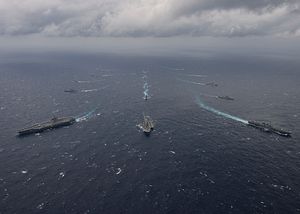The 21st edition of the Malabar series of exercises was held in the Bay of Bengal from July 10 to 17, 2017. The week long trilateral naval exercise, with the United States, Japan, and India as participants, was primarily aimed at promoting interoperability among the navies of the three countries and also to promote all round maritime cooperation among them.
The annual Malabar exercise started in 1992 as a bilateral event between the navies of India and the United States. It was an important step in the process of reviving New Delhi’s relationship with Washington, as both countries had occupied opposite ends of the spectrum during the Cold War. Over the years, the Malabar exercise has become a significant part of Indo-U.S. naval cooperation. It has grown into a complex multifaceted exercise, with an increase in the number of participating countries as well as enhancement of the nature of operations.
The 2007 edition of the exercise, held in the Bay of Bengal, was particularly significant, as for the first time ships from Japan, Australia, and Singapore also participated along with India and United States. However, Australia has not participated again since then, given the strong reaction from China to the event. It was only in 2014 that Japan again participated in the exercise, held in the western Pacific Ocean and in 2015 Japan became a permanent participant in the Malabar exercises. Recently, Australia has also expressed its willingness to rejoin the exercise.
Malabar 2017 has been the most complex iteration since the exercises’ inception, including both a sea phase in the waters of the Bay of Bengal and in-port interactions in Chennai. Around 16 ships, two submarines, and more than 95 aircraft from the three countries participated in the exercise. The U.S. Navy sent ships from Nimitz Carrier Strike Group from its 7th Fleet area of operations. According to a statement issued by the Indian Navy, India was represented by the “aircraft carrier INS Vikramaditya with its air wing, guided missile destroyer Ranvir, indigenous stealth frigates Shivalik and Sahyadri, indigenous ASW [anti-submarine warfare] corvette Kamorta, missile corvettes Kora and Kirpan, one Sindhughosh-class submarine, fleet tanker INS Jyoti and Long Range Maritime Patrol Aircraft P8I.” The Japanese Maritime Self Defense Force (JMSDF) sent its helicopter carrier JS Izumo.
The Indian Navy maintained at the commencement of the exercise that “the thrust of exercises at sea this year would be on Aircraft Carrier operations, Air Defense, Anti-Submarine Warfare (ASW), Surface Warfare, Visit Board Search and Seizure (VBSS), Search and Rescue, Joint Manoeuvres and Tactical procedures.”
The 2017 iteration of the exercise is particularly significant as it is being held amidst the heightened tension between India and China at the Doklam triboundary region near where the Bhutan-China-India borders meet. It is also important to note that, earlier this year India skipped Beijing’s Belt Road Forum, expressing displeasure over the Chinese One Belt One Road (OBOR) initiative, particularly given New Delhi’s reservations over the China-Pakistan Economic Corridor.
At the same time, over the past few years, the Chinese People Liberation Army Navy’s assertiveness in marking its presence in the Indian Ocean has been creating concern among regional and extra-regional countries. China has also been locked up in a long-standing dispute with neighboring Southeast Asian countries in the South China Sea. Although the United States and India are not direct parties to the conflict, they have been vocal about need to maintain freedom of navigation in the region. Last week China dispatched its troops to build its first overseas foreign base at Djibouti in the Horn of Africa; the move is likely to create further uneasiness in India and the United States.
However, official statements have downplayed the idea that the exercises were meant to send a message to China. Indian Flag Officer and Commander-in-Chief of Eastern Naval Command HCS Bisht maintained that the Malabar exercise “has nothing to do” with the stand-off between Indian and Chinese troops in the Doklam area. Similarly U.S. Rear Admiral William D. Byrne was cited as saying that the exercises were meant to send the same “strategic message” to China as to any other country.
China, on the other hand, has been known to be apprehensive about the Malabar exercises. China has been anxious of growing links between the Indian, U.S., and Japanese navies. Reacting to Malabar 2017, Chinese Foreign Ministry spokesman Geng Shuang argued that “we have no objection to the development of normal relations and cooperation between the countries. We hope such relations and cooperation are not targeted at a third country.” Although India and the United States have always maintained that aim of the naval exercise is streamlining interoperability, cementing professional ties, and preparing for Humanitarian Assistance and Disaster Relief (HADR) as well as Search and Rescue (SAR) operations, one of the aims of such cooperative efforts is also to maintain a balance of power in the Indo-Pacific region.
The annual Malabar 2017 exercise in the Bay of Bengal was one of the largest exercises held in the region. It provided an important platform for the navies of the three democracies to promote common understanding and demonstrate their shared commitment to enhance maritime security and stability in the region.
Pragya Pandey is a New Delhi based scholar. She has a Ph.D. from Jawaharlal Nehru University, New Delhi. She primarily works on the Indian Ocean and the wider Indo-Pacific region.
































